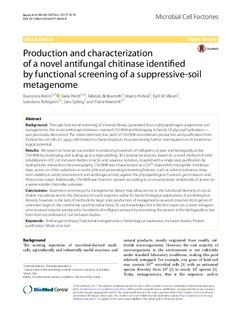| dc.contributor.author | Berini, Francesca | |
| dc.contributor.author | Presti, Ilaria | |
| dc.contributor.author | Beltrametti, Fabrizio | |
| dc.contributor.author | Pedroli, Marco | |
| dc.contributor.author | Vårum, Kjell Morten | |
| dc.contributor.author | Pollegioni, Loredano | |
| dc.contributor.author | Sjöling, Sara | |
| dc.contributor.author | Marinelli, Flavia | |
| dc.date.accessioned | 2017-11-27T10:07:15Z | |
| dc.date.available | 2017-11-27T10:07:15Z | |
| dc.date.created | 2017-06-14T15:18:41Z | |
| dc.date.issued | 2017 | |
| dc.identifier.citation | Microbial Cell Factories. 2017, 16:16 1-15. | nb_NO |
| dc.identifier.issn | 1475-2859 | |
| dc.identifier.uri | http://hdl.handle.net/11250/2468101 | |
| dc.description.abstract | Background
Through functional screening of a fosmid library, generated from a phytopathogen-suppressive soil metagenome, the novel antifungal chitinase—named Chi18H8 and belonging to family 18 glycosyl hydrolases—was previously discovered. The initial extremely low yield of Chi18H8 recombinant production and purification from Escherichia coli cells (21 μg/g cell) limited its characterization, thus preventing further investigation on its biotechnological potential.
Results
We report on how we succeeded in producing hundreds of milligrams of pure and biologically active Chi18H8 by developing and scaling up to a high-yielding, 30 L bioreactor process, based on a novel method of mild solubilization of E. coli inclusion bodies in lactic acid aqueous solution, coupled with a single step purification by hydrophobic interaction chromatography. Chi18H8 was characterized as a Ca2+-dependent mesophilic chitobiosidase, active on chitin substrates at acidic pHs and possessing interesting features, such as solvent tolerance, long-term stability in acidic environment and antifungal activity against the phytopathogens Fusarium graminearum and Rhizoctonia solani. Additionally, Chi18H8 was found to operate according to a non-processive endomode of action on a water-soluble chitin-like substrate.
Conclusions
Expression screening of a metagenomic library may allow access to the functional diversity of uncultivable microbiota and to the discovery of novel enzymes useful for biotechnological applications. A persisting bottleneck, however, is the lack of methods for large scale production of metagenome-sourced enzymes from genes of unknown origin in the commonly used microbial hosts. To our knowledge, this is the first report on a novel metagenome-sourced enzyme produced in hundreds-of-milligram amount by recovering the protein in the biologically active form from recombinant E. coli inclusion bodies. | nb_NO |
| dc.language.iso | eng | nb_NO |
| dc.publisher | BioMed Central | nb_NO |
| dc.rights | Navngivelse 4.0 Internasjonal | * |
| dc.rights.uri | http://creativecommons.org/licenses/by/4.0/deed.no | * |
| dc.title | Production and characterization of a novel antifungal chitinase identified by functional screening of a suppressive-soil metagenome | nb_NO |
| dc.type | Journal article | nb_NO |
| dc.type | Peer reviewed | nb_NO |
| dc.description.version | publishedVersion | nb_NO |
| dc.source.pagenumber | 1-15 | nb_NO |
| dc.source.volume | 16:16 | nb_NO |
| dc.source.journal | Microbial Cell Factories | nb_NO |
| dc.identifier.doi | 10.1186/s12934-017-0634-8 | |
| dc.identifier.cristin | 1476129 | |
| dc.description.localcode | © The Author(s) 2017. This article is distributed under the terms of the Creative Commons Attribution 4.0 International License (http://creativecommons.org/licenses/by/4.0/) | nb_NO |
| cristin.unitcode | 194,66,15,0 | |
| cristin.unitname | Institutt for bioteknologi og matvitenskap | |
| cristin.ispublished | true | |
| cristin.fulltext | original | |
| cristin.qualitycode | 1 | |

